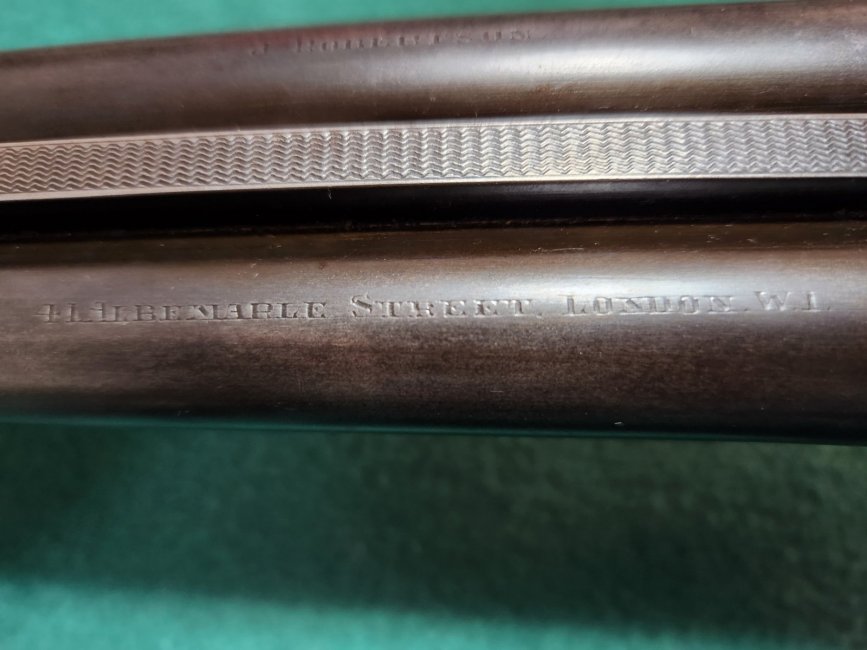For those of you who frequent the C&R subforum as well as the Shotgun subforum, you know that Old Western Scrounger recently had a winter sale (still going to Jan 31st 2024, discount code "SNOW" at checkout for 10% off) which saw some reasonable prices on some beater post-war P.38s. I wasn't really in the market for a P.38 but they sometimes have other cool stuff and with the discount code, it's tough not to look.
It turns out that they recently brought in a batch of English shotguns (along with some Italian and Spanish guns as well). I've always wanted a true English side-by-side so I started combing through the catalog to see what was available. Many showed with the lever well to the left of center and none of the makers aside from a few stood out. That was, until I came across the following stamped in the barrels of one particular gun, "J. Robertson 41 Albemarle St. London W.1"
London-made guns almost ALWAYS bring more money than Birmingham-made guns. That's because, by and large, the London gunmakers continued to use sidelocks for their shotguns instead of the Birmingham-born boxlock actions of Anson and Deeley or W.W. Greener. The sidelocks are more refined, leave more room for embellishment and engraving, and require a more deft hand with the stockwork due to the more complicated inletting. London is home to the top names in British guns, Purdey, Holland and Holland, and Boss & Co.
The interesting thing is that this gun is a Birmingham boxlock, not something you would typically find a London gunmaker selling, so I did what you do in this type of situation and started Googling information. What I found is that J. Robertson of 41 Albemarle St. London, W.1 is THE John Robertson who owned and ran Boss and Company Best Guns Only from the 1880s until his death in 1917. But the Boss & Co. name is nowhere on this particular gun, nor does it have the ornate and incredibly intricate engraving you would expect to see on a Boss & Co. gun. More digging was needed.
I did four things. I looked for other examples with the J. Robertson name and address (I found very few), I looked up the address to see if Boss & Co ever existed at that location (they did, from 1930 to 1960), I emailed Boss & Co about the gun (never expecting to get a word back) and I watched this video from TGS with Simon Reinhold of Holts Auction House:
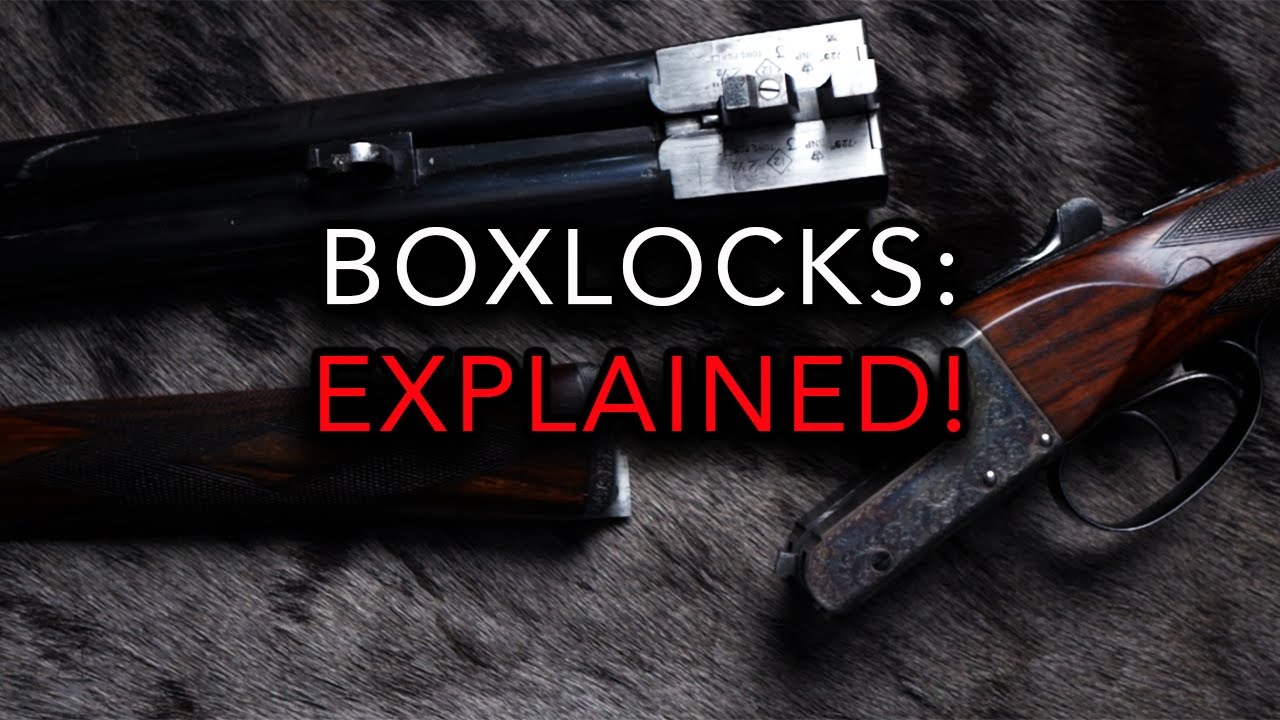
 youtube.com
youtube.com
I went ahead, rolled the dice, and bought the gun that evening. The next morning, Boss & Co. got back to me and let me know that yes, that is one of their guns. Being the second grade, which would have been something they would have sold to a gentleman buying a bespoke pair of Boss guns who also wanted something for his son, nephew, etc. they didn't have a sales record to look up and find out who bought it. Still, it is, for all intents and purposes, a Boss & Co. 2nd grade gun.
This particular gun carries Birmingham proofs and was likely produced sometime between 1930 and 1954 as Boss & Co. did not occupy 41 Albemarle Street until 1930, and the proof marks on the flats are of the type used up to 1954. It utilizes a greener cross-bolt on an Anson and Deeley box lock receiver. It's interesting to see the exposed greener cross-bolt on an action of this age as many manufacturers were using hidden bolts and hooks by that point.
I'd say it has between 30-35% of the case coloring still intact with a very nice patina on any surfaces in the white. The bores are in excellent condition and the raised rib gracefully rises from the bulk of the chambers to give the gun a distinct silhouette as it soars above the middle of the barrels only to just as gracefully mate nearly flat with the tops of the bores at the muzzle end. the beautifully filed matte finish and easily discernable single bead make for a fantastic sight picture when swinging through targets. The balance is superb with the gun perching stately on the hand just to the fore of the hinge, and the 30" barrels allow it to swing with ease.
As with many British game guns, this one has no steel or rubber butt plate. The Prince of Wales stock is unmolested at the butt with hand-carved checkering in place of any steel, rubber, bakelite, or horn. The length of pull is right in line with most of my other shotguns, and it mounts quickly and easily. The hand-checkered grips still retain excellent depth and function vs the stamped checkering of many American guns of the same era.
The double triggers are crisp with a clean break and short pulls. The poundage is a bit more than a modern gun, but not uncomfortable by any means. The triggers are held by an automatic safety which engages as the lever is pushed to the right. There are no ejectors on this gun, an oddity given the British insistence on ejectors. A simple extractor with a very prominent wedge forward of the hinge keeps your spent shells from leaping away as soon as you open the gun. The barrels are fully on the face with a nice tight lockup and the lever sitting at center. This gun was nitro-proofed for 2 3/4" shells with 1 1/4oz of shot. The chokes are IM and M (right and left bores respectively) so this was a fowling gun meant for driven game. There is a barely noticeable repair to the top right of the stop at the tang, but it was well executed. My only concern is that there is some space between the head of the stock and the iron at the back of the action. For any serious shooting, I'll have to have it bedded, but it'll be worth it.
I am pleased as punch with this gun. It's not incredibly fancy, but you can tell just how well it was made when you hold it in your hands. I'd put it up against any Parker or LC Smith out there. The engraving it does have is subtle, but very well executed. It may not be ornate, but the work that was put into it was of the highest quality possible. These really don't turn up over here that often, and the few that I have seen have had much heftier price tags than I could ever afford. It was definitely a lucky roll of the dice and I couldn't be happier. I might just have a new favorite gun.
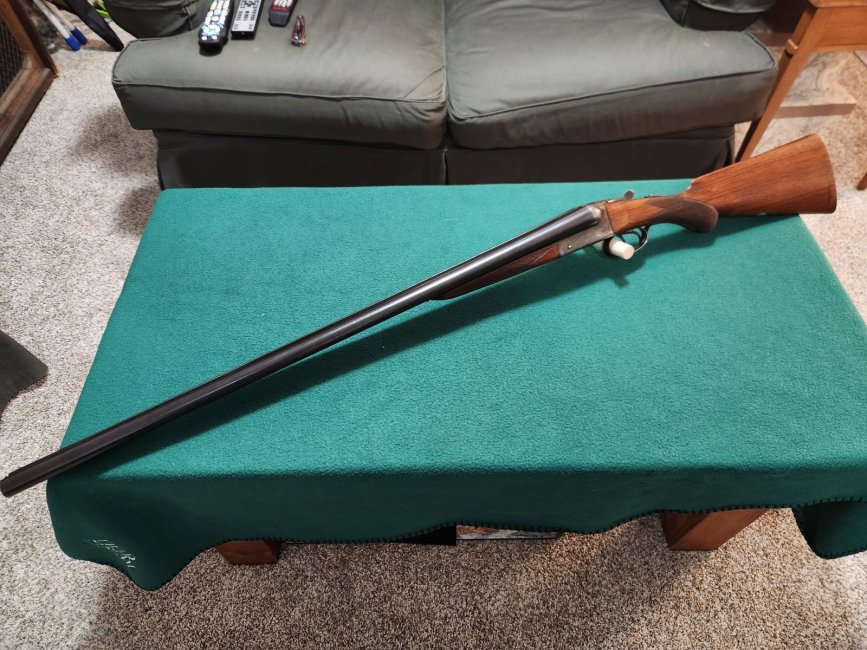
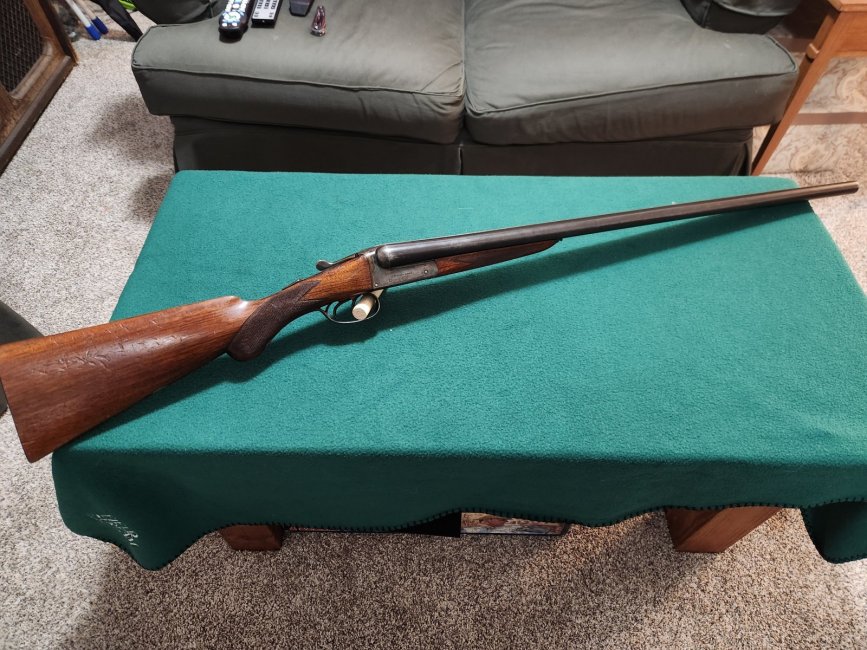
The engraving, though not extravagant, is well done with an even hand. The edges carry a vine motif around the whole of the receiver.
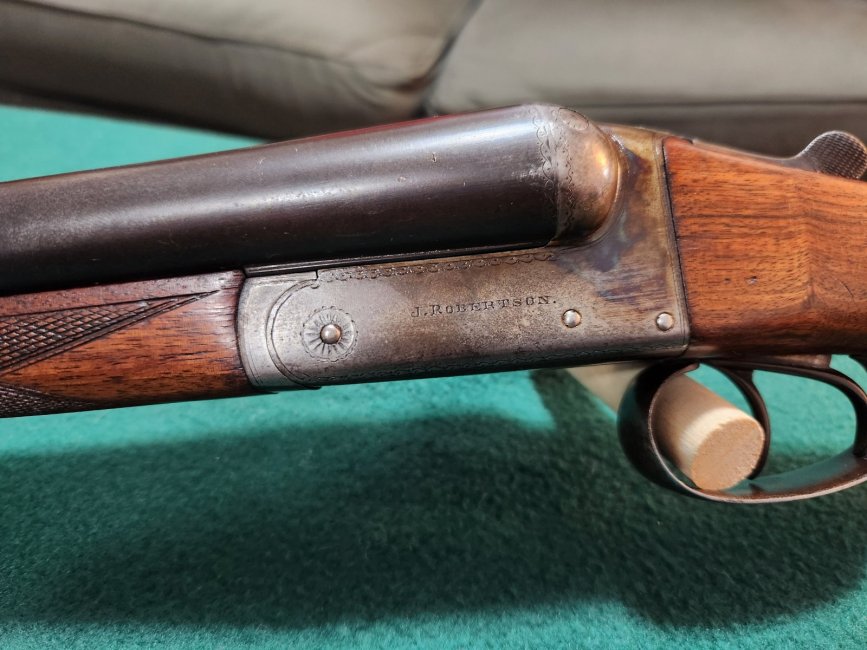
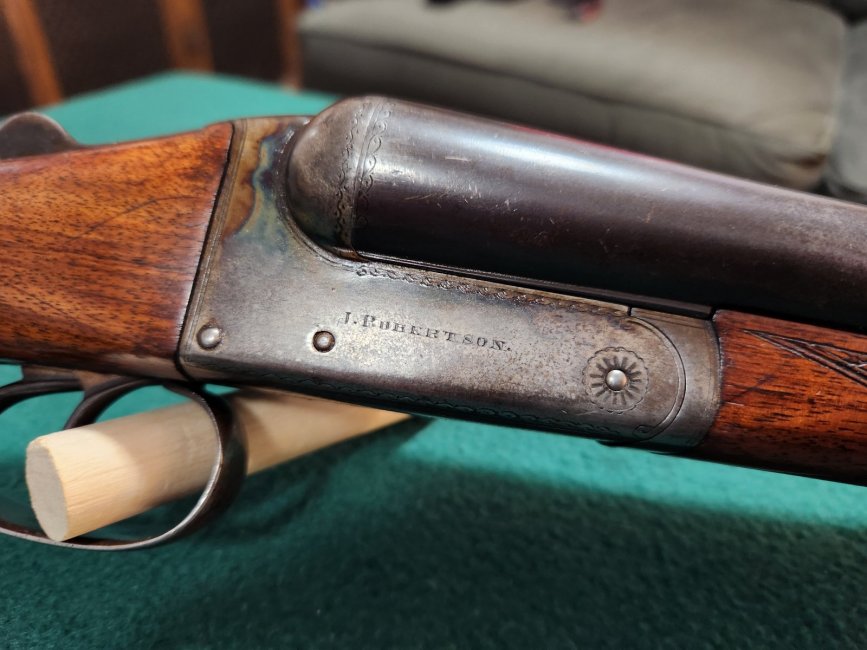
The engraving carries on through the bottom and on around the guard plate. The screws have straight slots with minimal buggering and all are engraved as well.
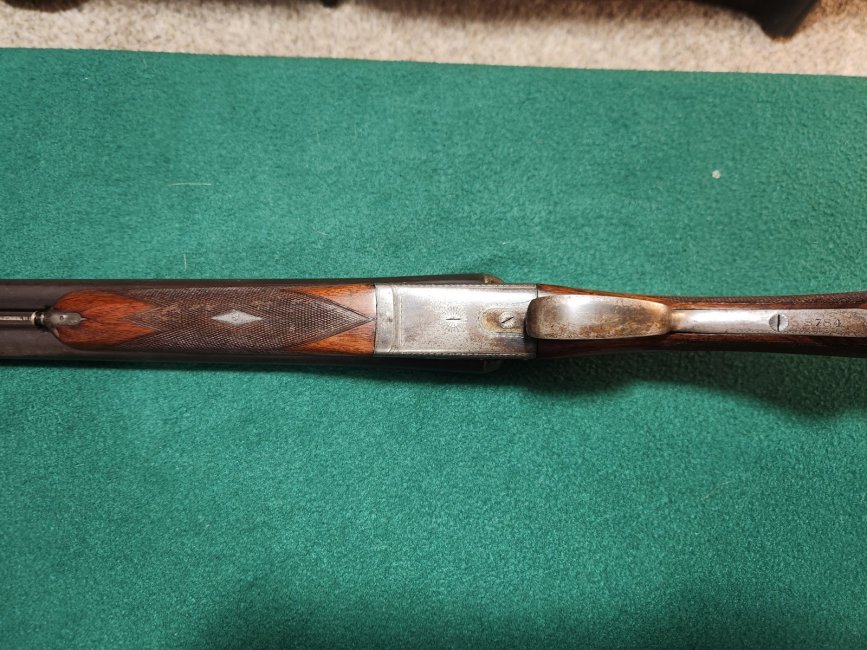
The top of the action, including the tops of the fences and detonators, still retains an excellent amount of case coloring with a beautiful patina anywhere it is missing.
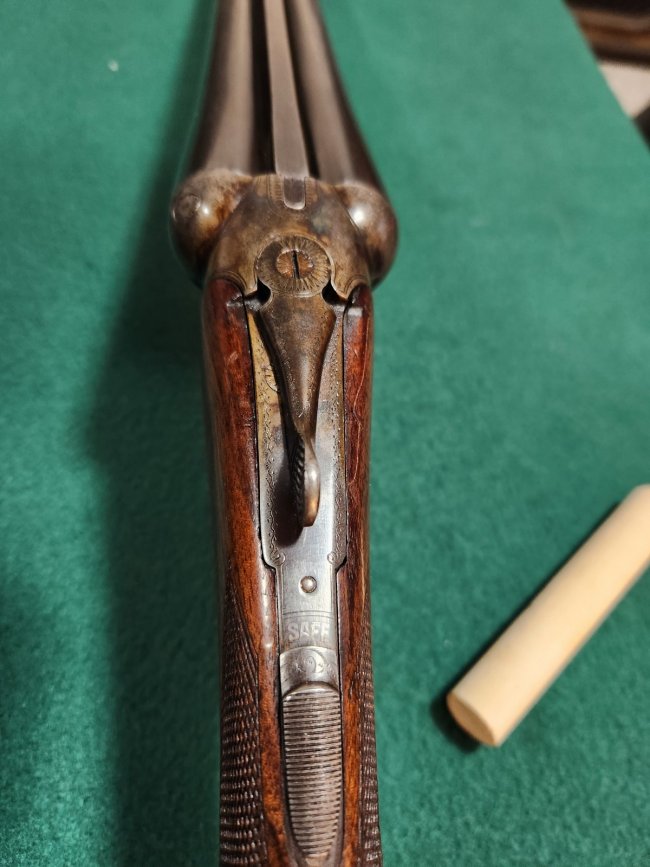
Here are the marks that sent me on the journey. OWS had it listed as "11 Albemarle Street" which would have shown no results. I guess they couldn't make out the '4' easily.
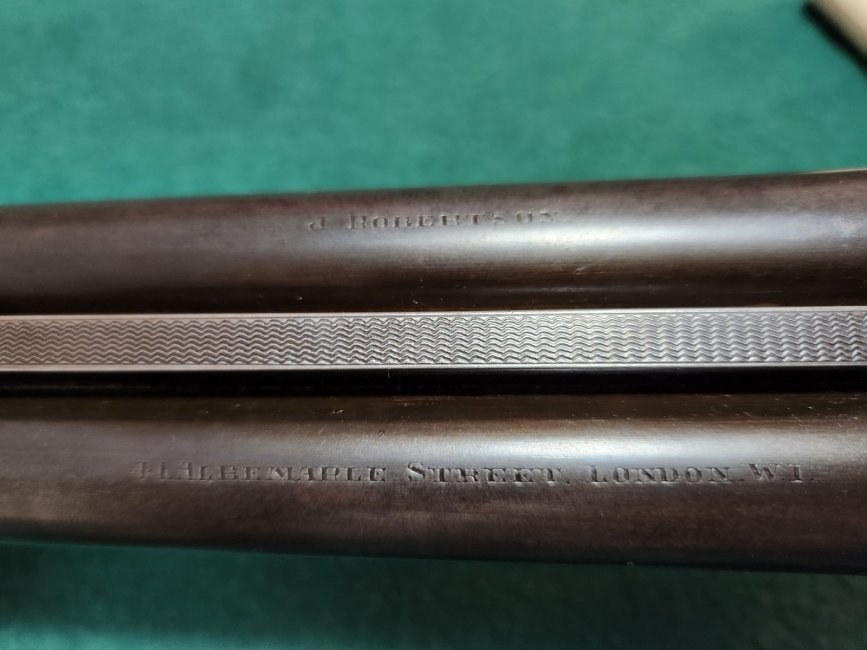
The checkering is still in excellent condition for a gun that is between 70 and 94 years old
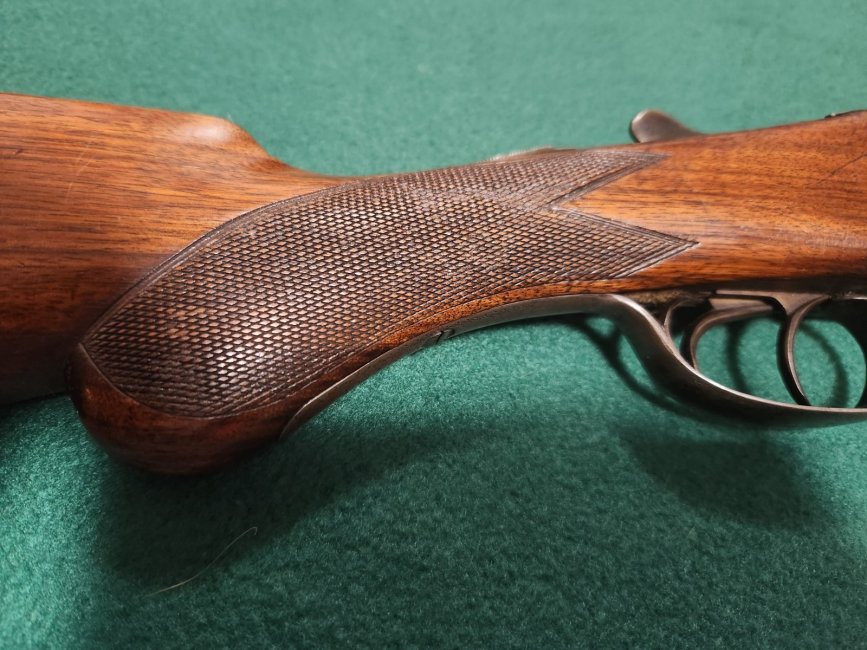
Like many older British field guns, there's no butt-plate or butt-pad for this shotgun. Padded vests or leather slip-over recoil pads are still widely used as their classic gun culture seems to focus on using historical arms more so than here in the US.
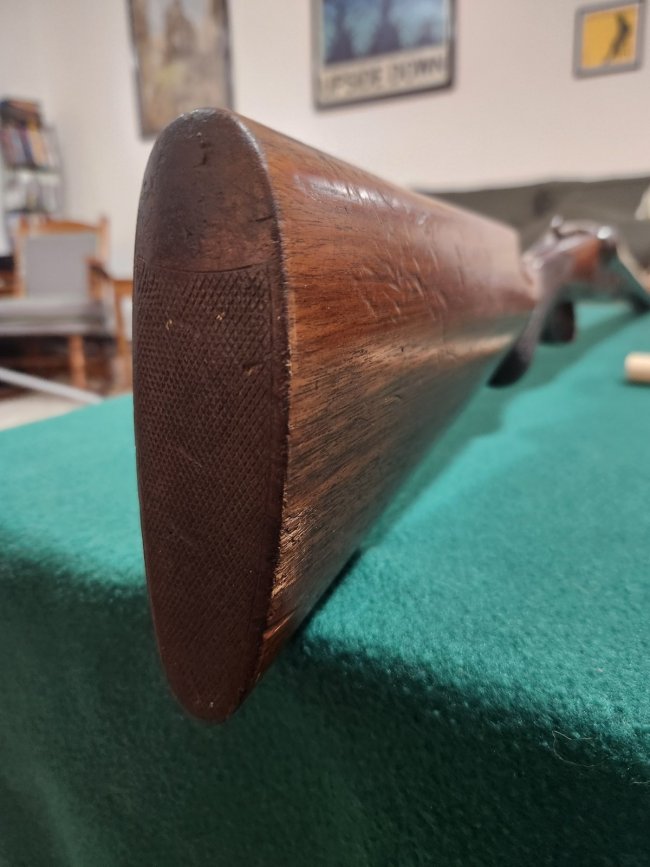
It turns out that they recently brought in a batch of English shotguns (along with some Italian and Spanish guns as well). I've always wanted a true English side-by-side so I started combing through the catalog to see what was available. Many showed with the lever well to the left of center and none of the makers aside from a few stood out. That was, until I came across the following stamped in the barrels of one particular gun, "J. Robertson 41 Albemarle St. London W.1"
London-made guns almost ALWAYS bring more money than Birmingham-made guns. That's because, by and large, the London gunmakers continued to use sidelocks for their shotguns instead of the Birmingham-born boxlock actions of Anson and Deeley or W.W. Greener. The sidelocks are more refined, leave more room for embellishment and engraving, and require a more deft hand with the stockwork due to the more complicated inletting. London is home to the top names in British guns, Purdey, Holland and Holland, and Boss & Co.
The interesting thing is that this gun is a Birmingham boxlock, not something you would typically find a London gunmaker selling, so I did what you do in this type of situation and started Googling information. What I found is that J. Robertson of 41 Albemarle St. London, W.1 is THE John Robertson who owned and ran Boss and Company Best Guns Only from the 1880s until his death in 1917. But the Boss & Co. name is nowhere on this particular gun, nor does it have the ornate and incredibly intricate engraving you would expect to see on a Boss & Co. gun. More digging was needed.
I did four things. I looked for other examples with the J. Robertson name and address (I found very few), I looked up the address to see if Boss & Co ever existed at that location (they did, from 1930 to 1960), I emailed Boss & Co about the gun (never expecting to get a word back) and I watched this video from TGS with Simon Reinhold of Holts Auction House:

✂️ J. Robertson
51 seconds · Clipped by tallen702 · Original video "Everything you need to know about Boxlocks" by TGS Outdoors
I went ahead, rolled the dice, and bought the gun that evening. The next morning, Boss & Co. got back to me and let me know that yes, that is one of their guns. Being the second grade, which would have been something they would have sold to a gentleman buying a bespoke pair of Boss guns who also wanted something for his son, nephew, etc. they didn't have a sales record to look up and find out who bought it. Still, it is, for all intents and purposes, a Boss & Co. 2nd grade gun.
This particular gun carries Birmingham proofs and was likely produced sometime between 1930 and 1954 as Boss & Co. did not occupy 41 Albemarle Street until 1930, and the proof marks on the flats are of the type used up to 1954. It utilizes a greener cross-bolt on an Anson and Deeley box lock receiver. It's interesting to see the exposed greener cross-bolt on an action of this age as many manufacturers were using hidden bolts and hooks by that point.
I'd say it has between 30-35% of the case coloring still intact with a very nice patina on any surfaces in the white. The bores are in excellent condition and the raised rib gracefully rises from the bulk of the chambers to give the gun a distinct silhouette as it soars above the middle of the barrels only to just as gracefully mate nearly flat with the tops of the bores at the muzzle end. the beautifully filed matte finish and easily discernable single bead make for a fantastic sight picture when swinging through targets. The balance is superb with the gun perching stately on the hand just to the fore of the hinge, and the 30" barrels allow it to swing with ease.
As with many British game guns, this one has no steel or rubber butt plate. The Prince of Wales stock is unmolested at the butt with hand-carved checkering in place of any steel, rubber, bakelite, or horn. The length of pull is right in line with most of my other shotguns, and it mounts quickly and easily. The hand-checkered grips still retain excellent depth and function vs the stamped checkering of many American guns of the same era.
The double triggers are crisp with a clean break and short pulls. The poundage is a bit more than a modern gun, but not uncomfortable by any means. The triggers are held by an automatic safety which engages as the lever is pushed to the right. There are no ejectors on this gun, an oddity given the British insistence on ejectors. A simple extractor with a very prominent wedge forward of the hinge keeps your spent shells from leaping away as soon as you open the gun. The barrels are fully on the face with a nice tight lockup and the lever sitting at center. This gun was nitro-proofed for 2 3/4" shells with 1 1/4oz of shot. The chokes are IM and M (right and left bores respectively) so this was a fowling gun meant for driven game. There is a barely noticeable repair to the top right of the stop at the tang, but it was well executed. My only concern is that there is some space between the head of the stock and the iron at the back of the action. For any serious shooting, I'll have to have it bedded, but it'll be worth it.
I am pleased as punch with this gun. It's not incredibly fancy, but you can tell just how well it was made when you hold it in your hands. I'd put it up against any Parker or LC Smith out there. The engraving it does have is subtle, but very well executed. It may not be ornate, but the work that was put into it was of the highest quality possible. These really don't turn up over here that often, and the few that I have seen have had much heftier price tags than I could ever afford. It was definitely a lucky roll of the dice and I couldn't be happier. I might just have a new favorite gun.


The engraving, though not extravagant, is well done with an even hand. The edges carry a vine motif around the whole of the receiver.


The engraving carries on through the bottom and on around the guard plate. The screws have straight slots with minimal buggering and all are engraved as well.

The top of the action, including the tops of the fences and detonators, still retains an excellent amount of case coloring with a beautiful patina anywhere it is missing.

Here are the marks that sent me on the journey. OWS had it listed as "11 Albemarle Street" which would have shown no results. I guess they couldn't make out the '4' easily.

The checkering is still in excellent condition for a gun that is between 70 and 94 years old

Like many older British field guns, there's no butt-plate or butt-pad for this shotgun. Padded vests or leather slip-over recoil pads are still widely used as their classic gun culture seems to focus on using historical arms more so than here in the US.


